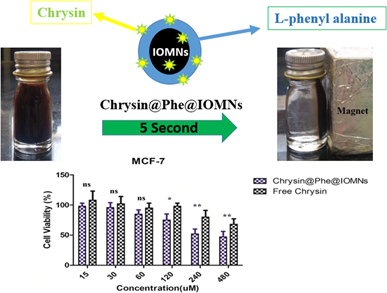Crossref Citations
This article has been cited by the following publications. This list is generated based on data provided by
Crossref.
Gorgieva, Selestina
Vuherer, Tomaž
and
Kokol, Vanja
2018.
Autofluorescence-aided assessment of integration and μ-structuring in chitosan/gelatin bilayer membranes with rapidly mineralized interface in relevance to guided tissue regeneration.
Materials Science and Engineering: C,
Vol. 93,
Issue. ,
p.
226.
Nosrati, Hamed
Charmi, Jalil
Abedini, Somayeh
Rashidi, Nafis
Attari, Elahe
Davaran, Soodabeh
Danafar, Hossein
and
Kheiri Manjili, Hamidreza
2018.
Preparation and characterization of magnetic theranostic nanoparticles for curcumin delivery and evaluation as MRI contrast agent.
Applied Organometallic Chemistry,
Vol. 32,
Issue. 12,
Zulkhairi Amin, Fatin Aina
Sabri, Suriana
Mohammad, Salma Malihah
Ismail, Maznah
Chan, Kim Wei
Ismail, Norsharina
Norhaizan, Mohd Esa
and
Zawawi, Norhasnida
2018.
Therapeutic Properties of Stingless Bee Honey in Comparison with European Bee Honey.
Advances in Pharmacological Sciences,
Vol. 2018,
Issue. ,
p.
1.
Varshosaz, Jaleh
Dayani, Ladan
Chegini, Sana Pirmardvand
and
Minaiyan, Mohsen
2019.
Production of a new platform based on fumed and mesoporous silica nanoparticles for enhanced solubility and oral bioavailability of raloxifene HCl.
IET Nanobiotechnology,
Vol. 13,
Issue. 4,
p.
392.
Gulla, Surendra
Lomada, Dakshayani
Srikanth, Vadali V.S.S.
Shankar, Muthukonda Venkatakrishnan
Reddy, Kakarla Raghava
Soni, Sarvesh
and
Reddy, Madhava C.
2019.
Nanotechnology.
Vol. 46,
Issue. ,
p.
255.
Park, Hyeji
Hong, Kicheol
Kang, Jin Soo
Um, Teakyung
Knapek, Michal
Minárik, Peter
Sung, Yung-Eun
Máthis, Kristián
Yamamoto, Akiko
Kim, Hyun-Kyung
and
Choe, Heeman
2019.
Acoustic emission analysis of the compressive deformation of iron foams and their biocompatibility study.
Materials Science and Engineering: C,
Vol. 97,
Issue. ,
p.
367.
Nosrati, Hamed
Javani, Elham
Salehiabar, Marziyeh
Manjili, Hamidreza Kheiri
Davaran, Soodabeh
and
Danafar, Hossein
2019.
Biocompatibility and anticancer activity of L-phenyl alanine-coated iron oxide magnetic nanoparticles as potential chrysin delivery system—CORRIGENDUM.
Journal of Materials Research,
Vol. 34,
Issue. 23,
p.
3976.
Zhang, Lijun
Hui, Junfeng
Ma, Pei
Mi, Yu
Fan, Daidi
Zhu, Chenhui
Chi, Lei
and
Dong, Yanan
2019.
PEGylation of Ginsenoside Rg3-Entrapped Bovine Serum Albumin Nanoparticles: Preparation, Characterization, and In Vitro Biological Studies.
Journal of Nanomaterials,
Vol. 2019,
Issue. ,
p.
1.
Rivera, Luis M. R.
Machado, Julhyana G.
Chandra Mathpal, Mohan
Chaves, Natalia L.
Gregurec, Danijela
Báo, Sônia N.
Paterno, Leonardo G.
Moya, Sergio E.
Azevedo, Ricardo B.
and
Soler, Maria A. G.
2020.
Functional glucosamine-iron oxide nanocarriers.
Journal of Materials Research,
Vol. 35,
Issue. 13,
p.
1726.
Hossain, Sadia
Rahman, Mahbubor
Nahar, Yeasmin
Rahman, Abdur
Sharafat, Mostafa Kaiyum
Hossain, Motahar
Ochiai, Bungo
Elaissari, Abdelhamid
and
Ahmad, Hasan
2020.
A simple in situ synthesis of iron oxide magnetic nanoparticles embedded in thermosensitive polymer for DNA capture.
Journal of Materials Research,
Vol. 35,
Issue. 18,
p.
2441.
Xia, Tingting
Wu, Heyan
Yin, Liangliang
and
Ji, Yanqin
2021.
Selective removal of cesium by ammonium molybdophosphate-magnetic Fe3O4-chitosan composites.
Journal of Materials Research,
Vol. 36,
Issue. 14,
p.
2926.
Sneha, K R
Sreeja, S
and
Sailaja, G S
2021.
Radiopacity endowed magnetic nanocomposite with hyperthermia and in vitro mineralization potential: a combinatorial therapeutic system for osteosarcoma.
Biomedical Materials,
Vol. 16,
Issue. 4,
p.
045029.
Ebadi, Mona
Buskaran, Kalaivani
Bullo, Saifullah
Hussein, Mohd Zobir
Fakurazi, Sharida
and
Pastorin, Giorgia
2021.
Drug delivery system based on magnetic iron oxide nanoparticles coated with (polyvinyl alcohol-zinc/aluminium-layered double hydroxide-sorafenib).
Alexandria Engineering Journal,
Vol. 60,
Issue. 1,
p.
733.
Bindhya, K. Purushothaman
Uma Maheswari, P.
and
Meera Sheriffa Begum, K.M.
2021.
Milk protein inspired multifunctional magnetic carrier targeting progesterone receptors: Improved anticancer potential of soybean-derived genistein against breast and ovarian cancers.
Materials Chemistry and Physics,
Vol. 272,
Issue. ,
p.
125055.
Beyaz, Seda
Aslan, Abdullah
Gok, Ozlem
Uslu, Harun
Agca, Can Ali
and
Ozercan, Ibrahim Hanifi
2022.
In vivo, in vitro and in silico anticancer investigation of fullerene C60 on DMBA induced breast cancer in rats.
Life Sciences,
Vol. 291,
Issue. ,
p.
120281.
Adangale, Shreya Chitrakant
and
Wairkar, Sarika
2022.
Potential therapeutic activities and novel delivery systems of chrysin-a nature’s boon.
Food Bioscience,
Vol. 45,
Issue. ,
p.
101316.
Solanki, Raghu
Jodha, Bhavana
Prabina, Kleopatra Eligy
Aggarwal, Niharika
and
Patel, Sunita
2022.
Recent advances in phytochemical based nano-drug delivery systems to combat breast cancer: A review.
Journal of Drug Delivery Science and Technology,
Vol. 77,
Issue. ,
p.
103832.
Dewanjee, Saikat
Chakraborty, Pratik
Bhattacharya, Hiranmoy
Singh, Sachin Kumar
Dua, Kamal
Dey, Abhijit
and
Jha, Niraj Kumar
2023.
Recent advances in flavonoid-based nanocarriers as an emerging drug delivery approach for cancer chemotherapy.
Drug Discovery Today,
Vol. 28,
Issue. 1,
p.
103409.
Dhavale, Rakesh P.
Dhavale, Rushikesh P.
Bhatia, Manish S.
Jadhav, Sagar U.
Dhanavade, Maruti J.
Barale, Sagar S.
Pathak, Sachin
Parale, Vinayak G.
and
Sonawane, Kailas D.
2023.
Exploring anticancer potential of nintedanib conjugated magnetic nanoparticles: In-vitro and in-silico studies.
Journal of Drug Delivery Science and Technology,
Vol. 81,
Issue. ,
p.
104213.
Majeed, Shahnaz
Mohd Rozi, Nazatul Adhwa Binti
Danish, Mohammed
Mohamad Ibrahim, Mohamad Nasir
and
Joel, Elsa Lycias
2023.
In vitro apoptosis and molecular response of engineered green iron oxide nanoparticles with l-arginine in MDA-MB-231 breast cancer cells.
Journal of Drug Delivery Science and Technology,
Vol. 80,
Issue. ,
p.
104185.
